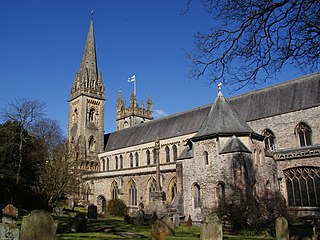
Llandaff Cathedral is an Anglican cathedral and parish church in Llandaff, Cardiff, Wales. It is the seat of the Bishop of Llandaff, head of the Church in Wales Diocese of Llandaff. It is dedicated to Saint Peter and Saint Paul, and three Welsh saints: Dubricius, Teilo and Oudoceus. It is one of two cathedrals in Cardiff, the other being the Roman Catholic Cardiff Metropolitan Cathedral in the city centre.
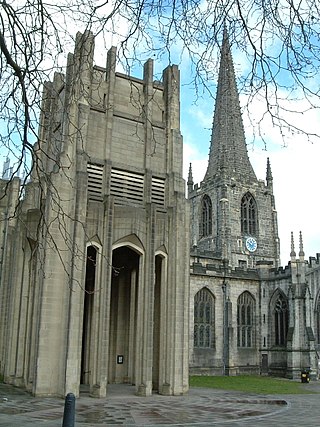
The Cathedral Church of St Peter and St Paul, Sheffield, also known as Sheffield Cathedral, is the cathedral church for the Church of England diocese of Sheffield, England. Originally a parish church, it was elevated to cathedral status when the diocese was created in 1914. Sheffield Cathedral is one of five Grade I listed buildings in the city, along with the Town Hall, Abbeydale Industrial Hamlet, and the parish churches at Ecclesfield and Bradfield.
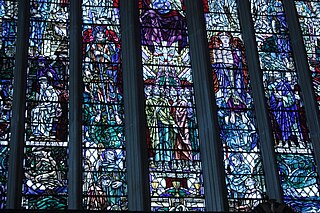
Douglas Strachan is considered the most significant Scottish designer of stained glass windows in the 20th century. He is best known for his windows at the Peace Palace in The Hague, Netherlands, at Edinburgh's Scottish National War Memorial and in cathedrals and churches throughout the United Kingdom. He is also known for his paintings, murals, and illustrations.

Clayton and Bell was one of the most prolific and proficient British workshops of stained-glass windows during the latter half of the 19th century and early 20th century. The partners were John Richard Clayton (1827–1913) and Alfred Bell (1832–1895). The company was founded in 1855 and continued until 1993. Their windows are found throughout the United Kingdom, in the United States, Canada, Australia and New Zealand.

Christopher Whitworth Whall was a British stained-glass artist who worked from the 1880s and on into the 20th century. He is widely recognised as a leader in the Arts and Crafts movement and a key figure in the modern history of stained glass.
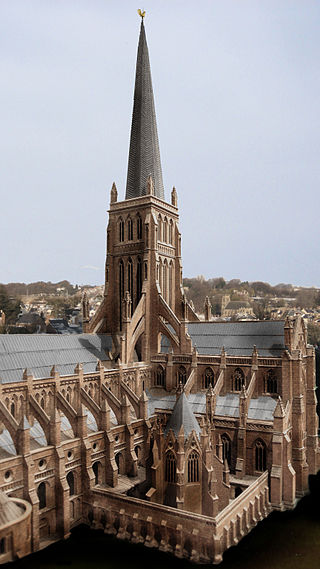
Old St Paul's Cathedral was the cathedral of the City of London that, until the Great Fire of 1666, stood on the site of the present St Paul's Cathedral. Built from 1087 to 1314 and dedicated to Saint Paul, this building was perhaps the fourth such church at this site on Ludgate Hill, going back to the 7th century.
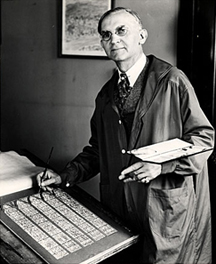
Charles Jay Connick (1875–1945) was a prominent American painter, muralist, and designer best known for his work in stained glass in the Gothic Revival style. Born in Springboro, Pennsylvania, Connick eventually settled in the Boston area where he opened his studio in 1913. Connick's work is contained in many preeminent churches and chapels, including examples in Boston, Chicago, Detroit, New York City, Pittsburgh, San Francisco, Seattle, and Washington, D.C. He also authored the book Adventures in Light and Color in 1937. Connick's studio continued to operate, and remained a leading producer of stained glass, until 1986.

Francis Walter Skeat was an English glass painter who created over 400 stained glass windows in churches and cathedrals, both in England and overseas. Skeat was a Fellow of the Royal Society of Arts, a Fellow of the British Society of Master Glass Painters, and a member of the Art Workers Guild.

Margaret Isobel Chilton (1875–1963), born at Clifton, Bristol, was a British stained glass artist and instructor.
Brian Thomas (1912–1989) was a British artist best known for his decorative work in church buildings, particularly murals and stained glass.
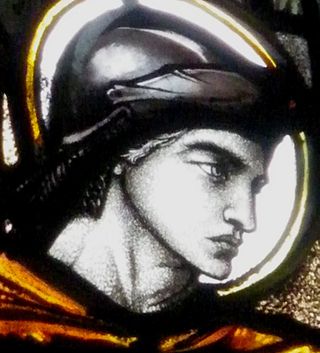
Rachel de Montmorency, née Rachel Marion Tancock, was an English painter and artist working in stained glass. She learned about stained glass when she worked for artist Christopher Whall in the 1910s and 1920s. During World War I she worked as a voluntary nurse.

Margaret Agnes Rope was a British stained glass artist in the Arts and Crafts movement tradition active in the first four decades of the 20th century. Her work is notable for the intensity and skill of the painting and the religious fervour underpinning it. She should not be confused with her cousin, Margaret Edith Rope, another British stained glass artist in the same tradition, active from 1910 until the mid-1960s, with whom she cooperated on some windows.
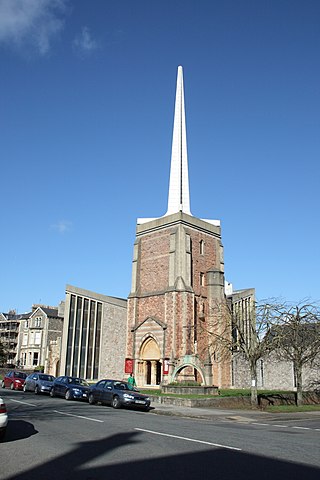
The Church of All Saints is a Church of England parish church in Clifton, Bristol. The church is a grade II listed building. It is located in the Parish of All Saints with St. John Clifton in the Diocese of Bristol.
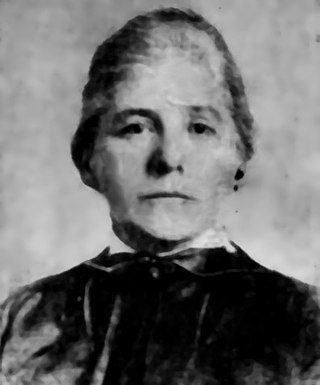
Margaret Redmond (1867–1948) was an American stained glass artist. Her work is characteristic of the medieval revival style, inspired by the fourteenth and fifteenth century stained glass of French and English cathedrals. She chose innovative glass materials, vibrant colors and thick leading designs for her windows, favored by the leading stained glass artists of the Arts and Crafts Movement in England. She is best known for her stained glass work from the 1920s to the 1940s, which can be found in churches, museums, homes and libraries from New Jersey to Maine.
Leonard Walker was a British painter and stained glass designer. His work was part of the painting event in the art competition at the 1928 Summer Olympics.

Geoffrey Fuller Webb was an English stained-glass artist and designer of church furnishings, based for most of his career in East Grinstead. He was a nephew of the architect Sir Aston Webb and a pupil of Charles Eamer Kempe and Sir Ninian Comper. His work, which draws on the Gothic Revival tradition, can be found in both Church of England and Roman Catholic churches, and in several cathedrals. It can be identified by his artistic signature, a spider's web.
















